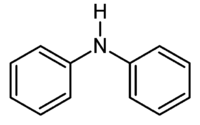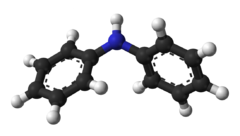- Diphenylamine
-
Diphenylamine 
 DiphenylamineOther namesN-Phenylbenzenamine;
DiphenylamineOther namesN-Phenylbenzenamine;
N-Phenyl Aniline;
DPA;
Anilinobenzene;
(phenylamino)benzene;
N,N-diphenylamine;
big dipper;
C.I. 10355;
Phenylbenzenamine;
Diphenylamine;Identifiers CAS number 122-39-4 
ChemSpider 11003 
UNII 9N3CBB0BIQ 
KEGG C11016 
ChEBI CHEBI:4640 
ChEMBL CHEMBL38688 
RTECS number 9 Jmol-3D images Image 1 - c1ccc(cc1)Nc2ccccc2
Properties Molecular formula C12H11N Molar mass 169.23 g/mol Appearance White crystals Density 1.2 g/cm³ Melting point 53 °C (326 K)
Boiling point 302 °C (575 K)
Solubility in water Slightly Hazards MSDS External MSDS R-phrases R23 R24 R25 R33 R50 R53 S-phrases S36 S37 S45 S60 S61 Main hazards Toxic. Possible mutagen. Possible teratogen. Harmful in contact with skin, and if swallowed or inhaled. Irritant. NFPA 704 Flash point 152°C Related compounds Related Amine Aniline Supplementary data page Structure and
propertiesn, εr, etc. Thermodynamic
dataPhase behaviour
Solid, liquid, gasSpectral data UV, IR, NMR, MS  (verify) (what is:
(verify) (what is:  /
/ ?)
?)
Except where noted otherwise, data are given for materials in their standard state (at 25 °C, 100 kPa)Infobox references Diphenylamine is the organic compound with the formula (C6H5)2NH. It is a colourless solid, but samples are often yellow due to oxidized impurities.[1]
Contents
Preparation and reactivity
Diphenylamine is manufactured by the thermal deamination of aniline over oxide catalysts:
- 2 C6H5NH2 → (C6H5)2NH + NH3
It is a weak base, with a Kb of 10−14. With strong acids, it forms the water soluble salt.
Applications
Diphenylamine is used as a pre- or postharvest scald inhibitor for apples. Its anti-scald activity is the result of its antioxidant properties, which protect the apple skin from the oxidation products of alpha-farnesene during storage.[2]
Diphenylamine derivatives are also useful. Ring-alkylated derivatives of diphenylamine are used as "antiozinates" in the manufacture of rubber products, reflecting the antioxidant nature of aniline derivatives. The compound undergoes various cyclisaton reactions. With sulfur, it gives phenothiazine, a precursor to certain pharmaceuticals.[3]
- (C6H5)2NH + 2 S → S(C6H4)2NH + H2S
With iodine, it cyclises to carbazole:
- (C6H5)2NH + I2 → (C6H4)2NH + 2 HI
Arylation with iodobenzene gives triphenylamine.[4]
Diphenylamine finds niche use as a test for nitrates (see nitrate test).
References
- ^ P. F. Vogt, J. J. Gerulis, “Amines, Aromatic” in Ullmann’s Encyclopedia of Industrial Chemistry 2005, Wiley-VCH, Weinheim.
- ^ "Apple Scald, a Complex Problem" W.J. Bramlage (University of Massachusetts Department of Plant and Soil Sciences) Post Harvest Pomology Newsletter, 6(2): 11-14 September 1988 http://postharvest.tfrec.wsu.edu/pgDisplay.php?article=N6I2C
- ^ T. Kahl, K.-W. Schröder, F. R. Lawrence, W. J. Marshall, Hartmut Höke, Rudolf Jäckh, "Aniline" in Ullmann's Encyclopedia of Industrial Chemistry, 2005, Wiley-VCH: Weinheim.
- ^ F. D. Hager (1941), "Triphenylamine", Org. Synth., http://www.orgsyn.org/orgsyn/orgsyn/prepContent.asp?prep=CV1P0544; Coll. Vol. 1: 544
External links
Categories:- Anilines
- Fungicides
Wikimedia Foundation. 2010.

